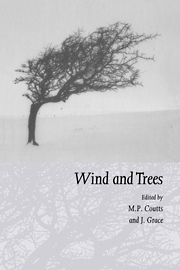Book contents
- Frontmatter
- Contents
- Preface
- List of contributors
- Part I Airflow over topography and in forests
- Part II Mechanics of trees under wind loading
- Part III Tree physiological responses
- Part IV Impacts of wind on forests and ecology
- Part V Risk assessment and management response
- 21 Assessing the risk of wind damage to forests: practice and pitfalls
- 22 Forest wind damage risk assessment for environmental impact studies
- 23 Recommendations for stabilisation of Norway spruce stands based on ecological surveys
- 24 Thinning regime in stands of Norway spruce subjected to snow and wind damage
- 25 A synopsis of windthrow in British Columbia: occurrence, implications, assessement and management
- 26 Wind damage to New Zealand State plantation forests
- 27 The experience of and management strategy adopted by the Selwyn Plantation Board, New Zealand
- Index
21 - Assessing the risk of wind damage to forests: practice and pitfalls
Published online by Cambridge University Press: 27 October 2009
- Frontmatter
- Contents
- Preface
- List of contributors
- Part I Airflow over topography and in forests
- Part II Mechanics of trees under wind loading
- Part III Tree physiological responses
- Part IV Impacts of wind on forests and ecology
- Part V Risk assessment and management response
- 21 Assessing the risk of wind damage to forests: practice and pitfalls
- 22 Forest wind damage risk assessment for environmental impact studies
- 23 Recommendations for stabilisation of Norway spruce stands based on ecological surveys
- 24 Thinning regime in stands of Norway spruce subjected to snow and wind damage
- 25 A synopsis of windthrow in British Columbia: occurrence, implications, assessement and management
- 26 Wind damage to New Zealand State plantation forests
- 27 The experience of and management strategy adopted by the Selwyn Plantation Board, New Zealand
- Index
Summary
Abstract
The nature of wind damage as a risk to managed forests is reviewed, based primarily upon experience in Britain. Risk assessment is required to guide site selection, choice of techniques to counter the damage, and plans to respond to damage. Assessment may simply rank sites but prediction of timing of damage is also needed for many decisions. Subjective assessments can be unreliable where there is little history of forest management in that locality or when the damage is determined by many factors. Objective assessments are preferred but are not easy to derive. The existing British windthrow hazard classification is readily applied to sites and can be mapped. However, both its treatment of the wind climate and its estimates of timing of damage are deterministic. The potential to improve the system is discussed using a conceptual model of the assessment of risk which highlights a number of important research issues. Wind damage occurs as a result of an interaction between a variable wind climate and changing tree vulnerability. Vulnerability includes persistent, progressive and episodic components. There can be substantial variability in the frequency and magnitude of damaging storms which is not adequately represented by the conventional separation into storms causing endemic and catastrophic damage. The change in vulnerability with time can have a very marked effect on the frequency of damage. Recent validation has indicated that the estimates of damage based on the hazard classification of damage tend to be pessimistic, and that there is more variability in rate of windthrow than the classification allows. The variability requires a stochastic model and necessitates flexible forest planning; the latter conflicts with many pressures on forest managers.
- Type
- Chapter
- Information
- Wind and Trees , pp. 379 - 403Publisher: Cambridge University PressPrint publication year: 1995
- 35
- Cited by



